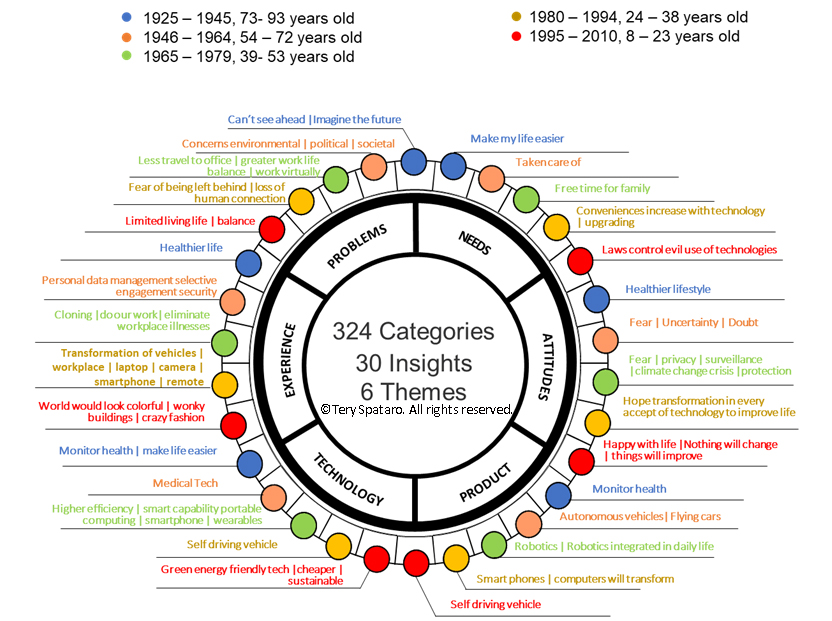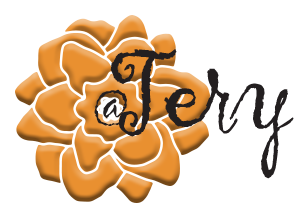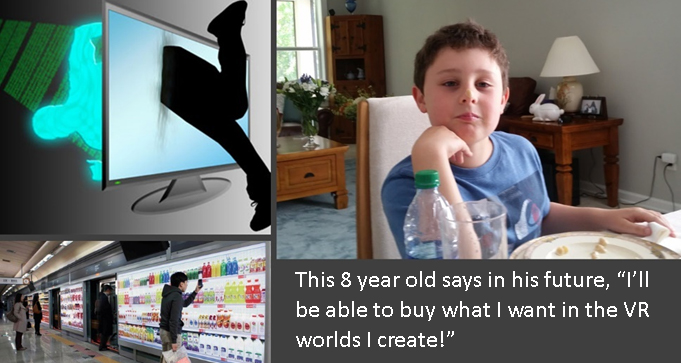Research approach: Survey, quantitative and qualitative.
Speculative fiction writer, William Gibson’s famous quote, the future is now; it’s just not evenly distributed, refers to everyday technological ordinariness within the lives of those already living in the future. Gibson’s quote may be right about ubiquity. There are many promises from technology that have not materialized about improving the lives of people with technology. There is a disparity between the commitment that technology will enhance the lives of the people, communities, and society and the delivery of benefits. People’s expectations differ widely on why, what, and how the technologies will improve their lives, and their future. Especially for personal assistants, wearables, smart appliances, driverless vehicles, augmented reality, virtual reality, and AI. This lack of cohesion leaves businesses frustrated on how best to design to create the desired needs and experiences.
As marketers and technologists, we aim to solve pain points and needs with technology. But often missing is the understanding of human needs through the lens of mindsets and life stages so that solutions for current and future technologies are justified and new opportunities discovered. Understanding human needs are necessary to the equation for solving today’s problems and pondering future opportunities.
Executives, marketers, and technologists need help in becoming knowledgeable in solving problems; there is a necessity to present a 360° perspective and insights acquired from human-centric research. The approach to human-centric research observes life stages, attitudes, and behaviors of people in their home, life, and on the go. I began the research project, Generations: Evolving Life Stages, to gather knowledge, understand the present state of the human condition, envision the future states as people transition through their life stages, to uncover opportunities that fit life stage transitions and use of technologies. Generations reveal attitudes towards technologies and scenarios of possible futures.
I applied Dr. Everett Roger’s Diffusion of Innovation Theory to explain life stage transitions and attitudes toward change and adoption of technology. Diffusion of Innovation Theory explains the transition of adoption and the socialization of innovated or transformed ideas. The research plan I designed applies a mix of qualitative and quantitative methods. The objective of the research is to demonstrate generational mindset attitudes towards change and adoption of technologies and validate the need for additional research with a more significant segment of the United States population. The outcome of this study is a reference for technology innovation or transformation based on generational insights and needs.
| Desired Technologies |
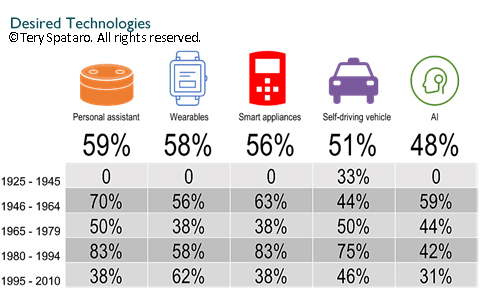 I targeted participants by age groups. In 2018, I began the first collection of impressions about the technology and future from life stage generations born between 1925-2010.
I targeted participants by age groups. In 2018, I began the first collection of impressions about the technology and future from life stage generations born between 1925-2010.
The first part of the study amassed demographic information, including gender, birth year, and lifestyle. The next part of the study identified the technologies participants own or use and desired technologies. Participants own/use 7.5 types of technologies, including high-speed internet, smartphone, computer/tablet, and smartTV. The technologies they want are personal assistants, wearables, smart appliances, self-driving vehicles, and AI. People born between 1925-1945 selected the least new technologies. I theorize this is because of a lack of knowledge about the latest technologies, but interestingly, 33% desire a self-driving car.
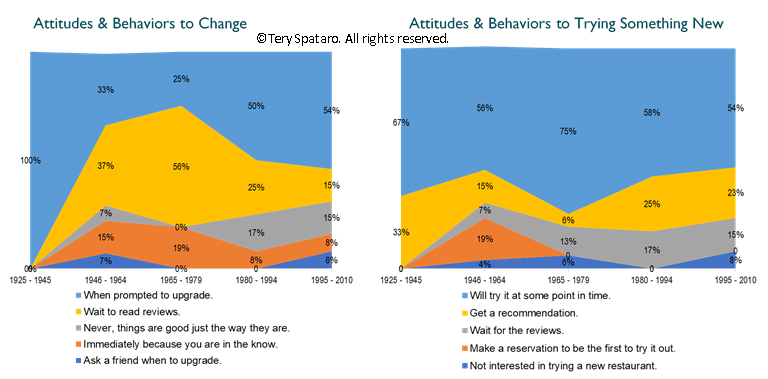
The next phase of the study divulged participants’ attitudes and behaviors to change and trying something new. Participants responded to questions about their practice in upgrading technology. The participants, as a whole group, will make the change when prompted to upgrade. But trying something new is a personal choice. When the participant chooses to experience something new, the experience will be on his/her schedule.
| Comparison of Participants’ Mindset to Roger’s Adoption Curve |
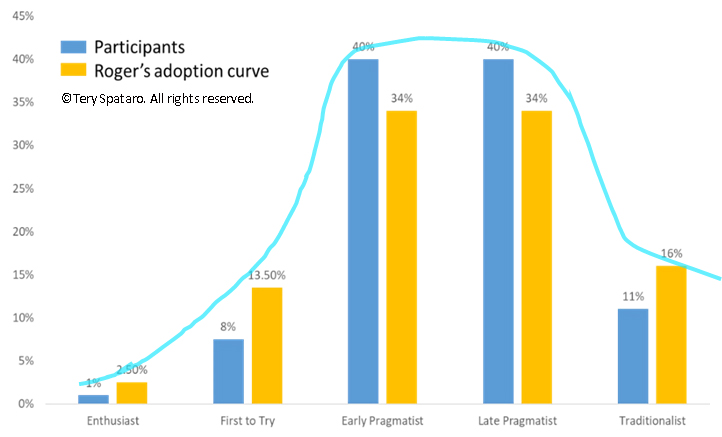 Using Roger’s adoption curve for comparison, I plotted the data points from trying something new and change exercises. The participants’ responses reacted to the curve as predicted. People who are more enthusiastic about technologies will be a small segment of the population and will be ahead in knowledge about technological change. Pragmatists will approach technology cautiously and are the tipping point of whether the technology will survive. Generations’ next study will validate this trend with a larger sample of the population gathered from a US panel.
Using Roger’s adoption curve for comparison, I plotted the data points from trying something new and change exercises. The participants’ responses reacted to the curve as predicted. People who are more enthusiastic about technologies will be a small segment of the population and will be ahead in knowledge about technological change. Pragmatists will approach technology cautiously and are the tipping point of whether the technology will survive. Generations’ next study will validate this trend with a larger sample of the population gathered from a US panel.
The last part of the study required participants to imagine the future in the year 2030. These questions used to gather emotional and rational responses toward the future and the need for future technologies. Participants describe and envision their life in 2030. These questions help the participants think about what their future needs will be. Their emotional and poignant responses were correlated and distilled into perceptions from fearful to hopeful.
| 1925 -1945 | Despair | Easier |
| Can’t see ahead or imagine the future | Technology will make my life easier & healthier | |
| 1946 -1964 | Uncertainty | Excited |
| Capability to work from home, I’m afraid I’ll have no reason to leave home! I hope the air is clean because I will not like virtual reality vacations. | Medical IoT devices for monitoring; holographic communications devices; robotic dispensers for pills/meds to maintain proper dosage(s), recalls help, automatically renew prescriptions. Stem cell advancements to extend life. | |
| 1965 -1979 | Fear | Hope |
| I’m not sure, but I hope AI is taken seriously as something that needs to be regulated! | Work-life balance, work virtually from home, not have to drive, spend more time with family, everything is delivered the same day to my door, all things are voice-activated. I love virtual reality. | |
| 1980 -1994 | Fear | Hope |
| I am experiencing technology disparity, I live in rural American, preventing most technological upgrades. I can imagine myself having financial sustainability & access to all necessary technology to satisfy my needs. | Self-driving cars will be available. Home food delivery will be much more prominent than now, include engineered vegan food and organic NGMO. | |
| 1995 -2010 | Fear | Better life |
| I think technology integrates into every aspect of life, but it can little concerning because of the lack of laws to help restrain it from being used to someone’s advantage. | I expect the future of transportation to change completely, self-driving cars used. More green energy-friendly technologies a lot cheaper and sustainable than current fossil-fuel sources. |
I took the data points from the participants’ stories distilled into trends, organized by life stage, problems, needs, attitudes, products, technologies, and experiences, and created the circular histogram of insights. Participants want a future that offers happiness and healthiness. They expressed wanting to be taken care of, more time with their family, and laws that protect them from illegal use or misuse of technologies. Participants discussed concerns with the environment, government, and society, and many expressed work-life balance, healthier life, and that technology should not overtake or replace human contact. They point out the technology in 2030 should keep society safe, make the environment greener and cleaner, and assist with happier, healthier living. The technology and products they envision in 2030 include medical technologies and health monitoring applications, efficient computing, AI-driven smart-tech devices, green tech, robots, and autonomous vehicles that integrate with their lives.
The circular histogram of insights corresponds to life stage needs, problems, technologies, products, and experiences. The display provides information and opportunities that lead to the formation of concepts, and there is no need to wait until 2030. For example:
- People in the transitional life stage, 1925 – 1945, are pragmatic and desire devices that monitor health, wellness, and quality of life. They are open to a virtual doctor.
- Pivotal life stage,1946 – 1964, they experienced the many changes, is at the shift of working and retiring, want a self-driving vehicle that will take them to and from appointments, so that their time is not wasted.
- Transformational life stage 1965 – 1979, most people are still working; but want a remote office equipped with time management and monitoring so that they can spend more time with family and friends.
- Up and coming life stage, 1980 – 1994 wants physical environments that connect people to people. They expressed the most significant request for technology, not taking over human contact.
- Forward-looking life stage segment, 1995 – 2010, the most enthusiastic about the future, wants the freedom to design and create their worlds.
These concepts are attainable with today’s technologies and will more likely be readily accepted and adopted. The overall intent of the findings provides a mindset indicator, present truths about acceptance of change and new concepts by the people who use your business, brands, products or services, and provide a framework for exploring transformation or innovation, and to expand the thinking of your business, leadership, and culture.
Gibson had a keen understanding of human behavior and the use of technology when he made his infamous quote. If you read any of William Gibson’s novels, you know he paints a technological dystopian future. Predicting the future may get easier with algorithms and quantum computers that calculate massive amounts of data and neatly sort findings into trends and forecasts in seconds. As of now, AI has a limited ability to understanding the complexities of human needs and expressions. By 2030, we may have flying cars, AI that helps us with our life’s decisions, robots that do our work or work for us, smart-tech devices that manage our health, wellness, and every need brought directly to our homes. The participants in my study redefined technology change to extend beyond physical forms into environmental forms. People recognize the value technology brings as they transition from one life stage to the next. They may feel afraid and uncertain and have doubts about the future. They also believe the future is exciting, and technology gives them hope that their lives will improve. As time moves forward, people will become more relaxed with technological changes and advances because technology will be firmly integrated and yet unnoticeable in their lives, home, and on the go.
| Histogram of Insights: Possible Futures in 2030 |
